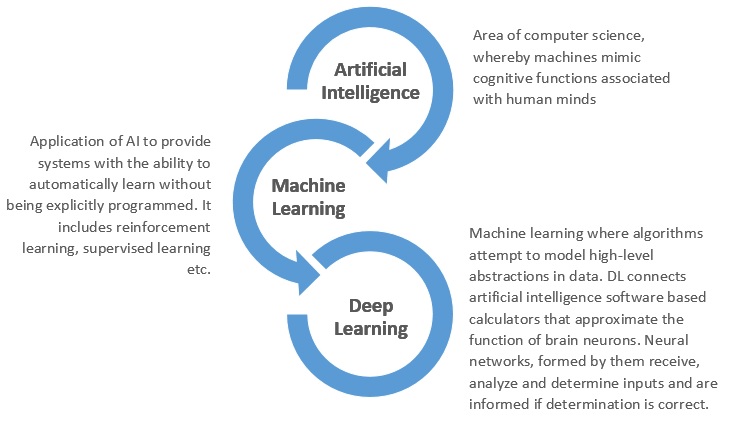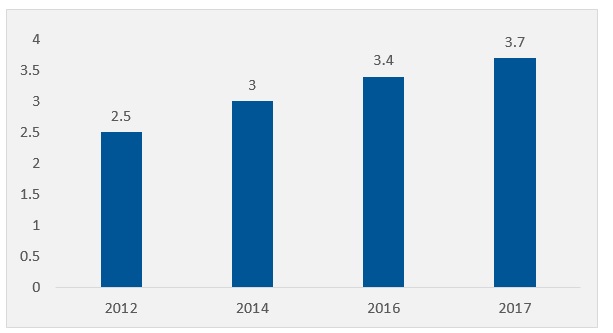This article originally published in AME Info.
Deep Learning has become one of the most discussed and researched topics of the decade. Deep learning is evolving day by day, and therefore, it is important to understand how and why it works. Deep learning sits at the intersection of Artificial Intelligence (AI) and machine learning.. AI basically implies a range of technologies that enable computer and robots to solve problems in ways that resemble human thinking process.
Within this realm is a smaller, yet significant component known as machine learning which enables software to function and predict outcomes more accurately without requiring external programming. Deep learning is the subset of machine learning that uses artificial neural networks having layers of learning capacities and algorithms to process large amounts of data.
The network starts by learning something simple at the initial level and sends this information to the next level. This is combined with a slightly more complex bit and is transferred to the third level. This process continues with each level creating something more complex from the input it received from the previous level.
Deep Learning is interlinked with AI and Machine Learning Source: Nvidia; Science in the News, The history of Artificial intelligence.
Source: Nvidia; Science in the News, The history of Artificial intelligence.
Data is the fundamental resource that makes deep learning possible as its algorithm requires tons of data to learn from. Global Internet population has increased 7.5% in 2016 to reach 3.7 billion people in 2017. The amount of data that is generated every day is currently estimated at 2.6 quintillion bytes (www.forbes.com). Higher computing power and the widespread use of AI-as–a-service which has given smaller organizations access to AI and AI algorithm without a large initial investment has strengthened deep learning.
Global Internet Population Growth 2012-2017 (In Billions)
Source: domo.com
Real World applications of Deep Learning
Deep learning models are applied to big data for knowledge discovery, knowledge application, and knowledge-based prediction, making it a powerful engine for producing effective and actionable results. It has the potential to learn from unlabeled or unstructured data. A few of the real-world applications of deep learning are listed below:
- Customer Experience
Businesses use deep learning to enhance the customer experience by personalizing it. Combining usage analytics, AI and machine learning capabilities, customer data can be utilized to provide unique services and experience to each customer. It also enables self-service to customers, thus increasing operational efficiency of the organization. It also ensures customer satisfaction which is key for customer retention. Deep learning models are already in use for chatbots with respect to enhancing customer experience.
- Translations
Deep learning improves automatic translation of texts with the use of stacked networks of neural networks and allowing translations from images.
- Adding color to images
Deep learning algorithms can be used to automatically add color to black and white images in a much faster way. They use the contexts and objects in the images to color them, thus recreating black- and white images in color accurately.
- Autonomous Vehicles
There are multiple deep learning models at work simultaneously in the case of autonomous vehicles. Some specialize in street signs while others are trained to recognize pedestrians. Various AI models work in isolation and combination to provide the vehicle with the apt commands while it is in operation.
- Computer Vision
Deep learning enables machines to automate the tasks performed by humans. It provides accuracy in image classification, object detention, image restoration and image segmentation.
- Image Caption generation
Deep learning has the capacity to recognize an image and develop an appropriate caption using an appropriate sentence structure and punctuation, similar to what a human can write.
- News aggregator based on sentiment
With the use of sentiment analysis or opinion mining, the attitude of an individual; or group regarding a particular topic or overall context is determined. This is used by news aggregators to filter and stream news relevant to the audiences’ interests.
- Medicines and pharmaceuticals
In the field of medical sciences particularly in diagnosis and personalized medicine creation using the individual’s genome, deep learning is making huge impact.
Enormous computational power is required to solve deep learning problems and develop deep learning models because of the iterative nature of its algorithms, their complexity it goes up the hierarchy, and the large volumes of data needed to train the networks.
At present, deep learning is at a very nascent stage, hence the limitations of its algorithms are still being explored. Despite the progress in the field, experts say that human level AI is still far from being achieved. The current models can only perform local generalization which means that they are capable of adapting to new situations that must be similar to past data.
On the contrary, human cognition is capable of extreme generalization, quickly adapting to completely unprecedented situations and planning for long-term future situations with the power of abstract modeling of hypothetical situations.
Applications of AI in Banking, Investing, Insurance and Capital Markets
The most basic type of AI is the Expert System. This is a decision-making system that is rule-based, making logical decisions based on known rules, and can learn mostly through inference. Some others make use of deep neural networks (DNN).
Artificial Neural Networks (ANN) are inspired by peoples’ own human brains. They learn by observing and increase their knowledge from processing the material that they experience. A website offers AI Product that continuously follows over 400 of the highest volume stocks from the Dow, S&P500, and NASDAQ.
It gives buy/sell/hold signals throughout the day, with the percentage of confidence in that signal stated to be nearing 100% near the end of the trading day. It does not trade for use. It simply provides a signal that investor can follow by choice. How one follows is up to investor. Other applications are mentioned below:
– Speeding up Transaction: Investors began tinkering with AI technology to increase the number of stocks that could be purchased simultaneously and automatically if a given set of market parameters are met.
– Predicting Stock Trends: Traders began to really take notice of the capabilities of AI technology, however, when the first algorithms predicting market trends were produced at the end of the last century.
Companies like Neural Tip use neural networks that are stated to be composed of multiple layers of nodes that use predetermined algorithms and trends seen in raw data to model market trends, effectively thinking about and drawing conclusions from the input information based on stock trading signals. Even more impressively, these systems are claimed to be able to learn new models and relationships between data according to newly compiled data.
It is reported that non-linear decision making computer programs that attempt to make the “best” decision not based on linear logic but instead on random inputs (like the information many people would have concerning a stock) are attempting to more closely model the type of decision making used by humans in an effort to better reflect our comprehensive problem solving capabilities.
According to a report by Accenture, capital markets are poised to be transformed by AI. However, until now, most firms have focused on using these technologies to cut costs, but AI has the potential to create value across the organization in entirely new ways.
What makes AI so transformative is its ability to learn. Deterministic technologies that mimic human behaviors are being superseded by intelligent systems that not only perform at or beyond human capacity, but evolve and develop new capabilities like people too. That’s creating new opportunities for capital markets firms to not only cut costs, but to add value for clients, employees and other stakeholders across the organization.
AI in Banking
AI technologies are increasingly being applied in the banking industry, mainly toward knowledge management, identity authentication, market analysis, customer relationship management, anti-money laundering, and risk control.
ANN have been tested to the complex banks’ problem of credit risk analysis. The tests have been to assess whether Stochastic neural networks can improve the credit rating accuracy of conventional deterministic system. Demographic and biographic information, in addition to traditional financial and economic credit scoring information, is also used as inputs to the ANN classifier in order to determine if the ability and accuracy of predicting credit default can be increased.
In insurance industry, from the first interaction (when determining what coverage is best to ongoing customer service), machines are continuing to play an increasing role in customer service.
According to one survey, most customers don’t have an issue with interacting with a bot; 74% of consumers would be happy to get computer-generated insurance advice. As a highly regulated industry, the insurance industry processes thousands of claims and responds to thousands of customer queries. AI is being used to improve this process and move claims through the system from initial report to communicating with the customer.
In some cases, these claims do not require any human interaction at all. Those companies that have already begun to automate portions of their claims process are realizing the time savings and increased quality of service.
Stay Tuned To Marmore MENA Insights!
Never miss a patch or an update with Marmore's Newsletter. Subscribe now!
Related Article
The uptick in MENA Eurobond issuances – A sign of things to come?
MENA debt issuances have touched record highs in Q1 2025. Will the uptick continue in subsequent quarters?
Read MoreKuwait’s Approval of Public Debt Law: Re-emerging on Investors’ Radar
Kuwait has passed the long-awaited debt law in March 2025. The blog explores the importance of the law, the expected benefits and outlook for the countrys return to debt markets.
Read MoreThe Dynamic Rise of Fintech in the GCC
The convergence of technology and finance is reshaping the GCC Financial Ecosystem. The blog explores key players, regulatory framework and market dynamics of Fintech in the GCC region.
Read More




